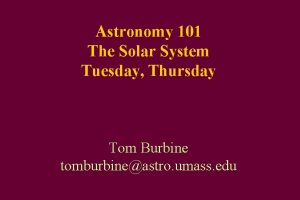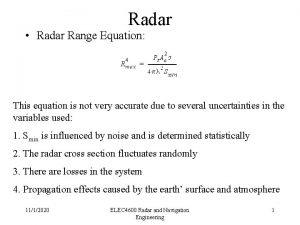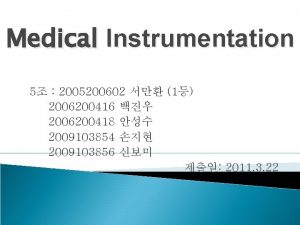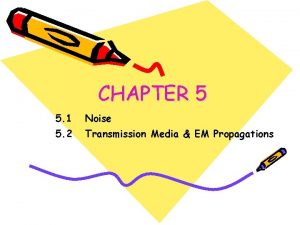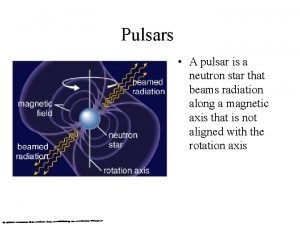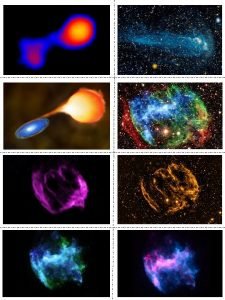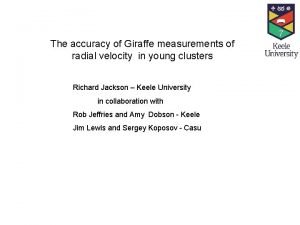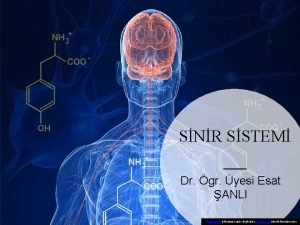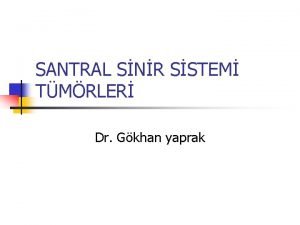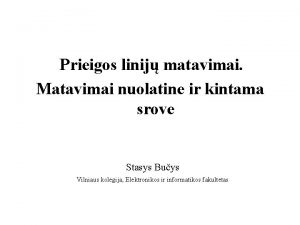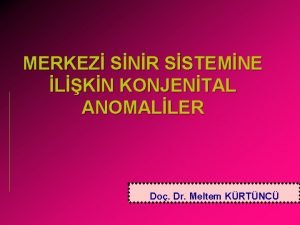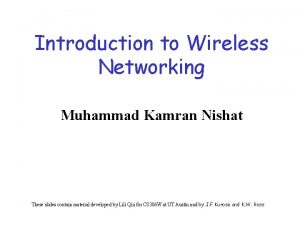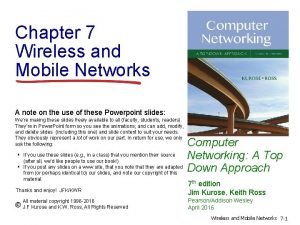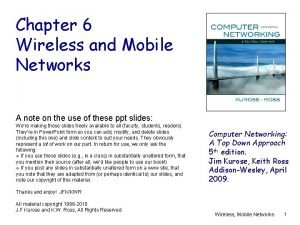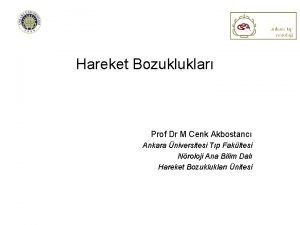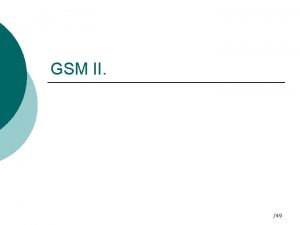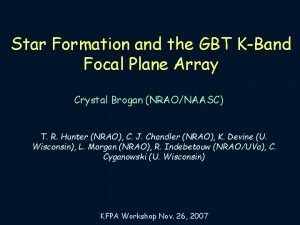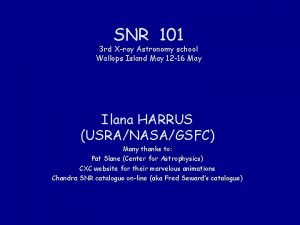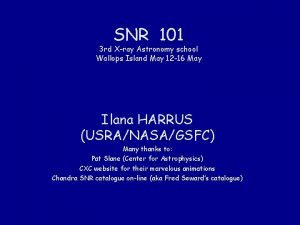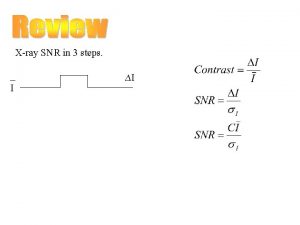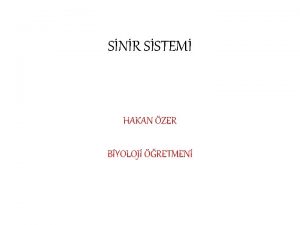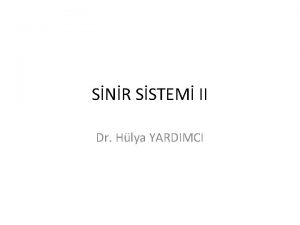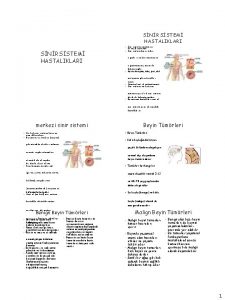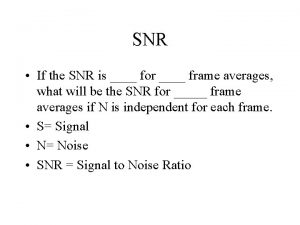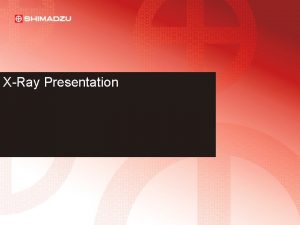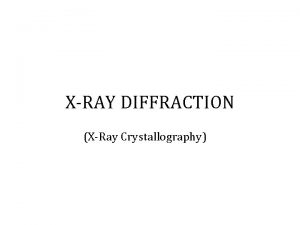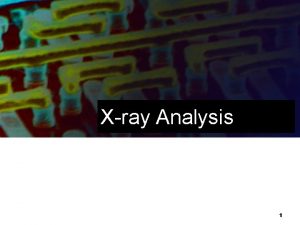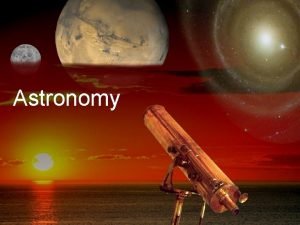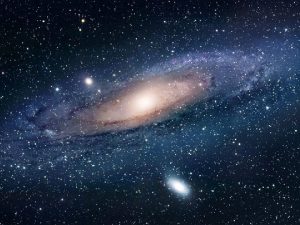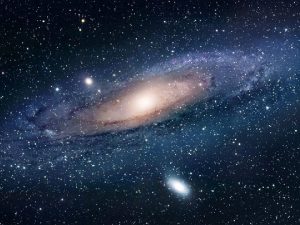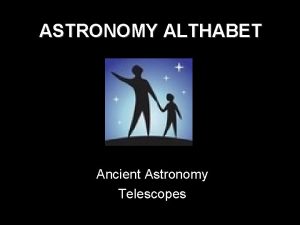SNR 101 3 rd Xray Astronomy school Wallops





























- Slides: 29

SNR 101 3 rd X-ray Astronomy school Wallops Island May 12 -16 May Ilana HARRUS (USRA/NASA/GSFC) Many thanks to: Pat Slane (Center for Astrophysics) CXC website for their marvelous animations Chandra SNR catalogue on-line (aka Fred Seward’s catalogue)

What are SNRs ? SNRs: Super. Nova Remnants are the tracers of explosions from stars reaching the end of their lifes. SNRs also enrich the ISM by dispersing material produced both during the star’s life and at the moment of the SN event. How frequent? Estimates varies according to SN types, environment (Galaxy type), …: About 2 per century for Milky Way (all types)

Why should we (you) care? SNRs are probes both of their progenitor star (and of their pre-supernova life) and of the ISM. They are also cosmic accelerators (cosmic rays). Birth places of neutron stars and stellar mass black holes. They can also be space laboratories for study of high magnetic fields, shock physics, jets, winds, (PWNe)…



Now the real story…. is a lot darker…. • Morphology classification is a zoo • Spectral classification is a royal mess

Hughes et al. 2000, Ap. J, 528, L 109 Park et al. 2002, Ap. J, 564, L 39


Hughes & Slane 2003, Ap. J (submitted) Park et al. 2002, Ap. J, 564, L 39

NO “YES” “Mostly thermal? YES NO Compact Object? NO Shell-like? YES Mostly Thermal? NO/? NO NO Pulsar associated? Is this a SNR? YES Shell-like? YES NO Mostly Thermal? YES NO NO Mostly Thermal?

Why is this such a mess? ? SNR evolution (and their appearance now) depends on many factors: • Its age • Its environment (density) • The total energy of the explosion and … its progenitor star (mass, type of SN associated. . )

3 phases in SNR’s life. • Free expansion (less than 200 -300 years) • Adiabatic or “Taylor-Sedov” phase (about 20, 000 years) • Radiative or Snow-plow phase (up to 500, 000 years) and then … Merge with the ISM

Free expansion phase • Independent of the nature of the SN explosion • No deceleration • Evolution only depends on Eo the initial energy. • Velocity of ejected shell varies between (7 -12) 103 km s-1 • Mass swept-up negligible until Msu ~ Meje ~ 1 M ===> Rs = 250 yrs Meje 5/6 n 1 -1/3 E 51 -1/2 SNR enters then its Adiabatic Phase


Sedov-Taylor phase The key word here is SELF SIMILAR solutions elsewhere) ===> f(r, t) becomes f(r/rref) *f(rref) (skipping the equations) … Et voilà! Rs=12. 4 pc (KE 51/n 1)1/5 t 4 2/5 t ==390 yr Rs Tmeas-1/2 (solutions can be scaled from

Sedov-Taylor phase The Sedov-Taylor phase is one the most often used in papers about SNRs (that’s because one can get actual physical quantities from measurements). In Sedov-Taylor model one expects thermal emission coming from a thin shell behind the blast wave. As the shock expends the pressure drops between the shock wave and the material ejected. At one point, “reverse” shock starts propagating ===> will eventually heat the ejecta (also thermal emission).


Radiative phase T drops as a steep function of radius ===> at some point, T is below Trecomb ~ 1 ke. V Age of SNR when this happens depends on models for cooling functions, explosion energy and density. Between 17, 000 and 25, 000 years (assuming standard Eo and n 1) Then: THE END… SNR merges with surrounding medium

Why so complicated then? ? • Different explosion energy, age, … • Different angle of visions • Amount of material along line of sight is not uniform • ISM is not homogenous • Different progenitor histories • …. .

First the simplest: • Different angle of view: §Then we may see the SNR “through” a lot more of absorption.

ISM not homogenous Several models to explain differences with Sedov -Taylor “shell-like” predictions. “Several” clouds evaporating “slowly” behind shock wave (White & Long, 1991) Several problems with this type of models.

Different progenitors Type Ia: thermo- nuclear destruction of an accreting white dwarf. Low O/Fe ratio. Type II: Core collapse of massive star. High O/Fe ratio.

Hughes et al. 2000, Ap. J, 528, L 109 Park et al. 2002, Ap. J, 564, L 39

Pulsar Wind Nebulae (in SNRs) § Recent developments (using Chandra) of PWNe studies (particle acceleration, magnetic fields, jets, winds, …)

Pulsar Wind Nebulae Studies of PWN can yield information on magnetic fields, …. With the new data increase from Chandra (and the spatial resolution), it is now possible to start doing statistical analysis. Gotthelf 2003


What was not mentioned here: § Non-equilibrium ionization effects § Non-thermal emission at the shock wave (SN 1006) §Accuracy of the spectral diagnostics §Association of PSR/SNR §…

For more information on SNRs: Books and proceedings: §“Supernovae and Stellar Wind in the ISM” T. Lozinskaya §“ Supernovae and supernova remnants” K. Weiler §“Neutrons stars in supernova remnants” (proc)-- Slane and Gaenlser (Eds. ) §“Exploring the X-ray Universe” Charles & Seward Articles: §Trimble -- Rev. Mod. Phys. 1982 Vol 54, No 4 §Mc. Kee -- Ap. J 1974188 355 §Chevalier -- Ap. J 1974 188 501 §Hamilton, Sarazin & Chevalier 1983 Ap. J Supp, 51 115

Conclusions SNRs (and PWNe) are a complicated but important field of study. Thanks to Chandra (its spatial resolution and its ability to allow for spatially resolved spectroscopy) and XMM-Newton (its large effective area and its ability to collect many more photons. ) ===>large rethinking of the field is happening now Any questions?
 Learning astronomy by doing astronomy
Learning astronomy by doing astronomy Learning astronomy by doing astronomy answers
Learning astronomy by doing astronomy answers Learning astronomy by doing astronomy
Learning astronomy by doing astronomy Astronomy 101 formulas
Astronomy 101 formulas Snr 공식
Snr 공식 Radar range equation snr
Radar range equation snr Snr 공식
Snr 공식 Contamination by extraneous signals from human sources
Contamination by extraneous signals from human sources Snr 공식
Snr 공식 Neutron star
Neutron star The quantum of a quantizer in delta modulation is
The quantum of a quantizer in delta modulation is Tychos snr
Tychos snr Snr değerleri
Snr değerleri Snr giraffe
Snr giraffe Koma skoru
Koma skoru Snr
Snr Snr
Snr Radar range equation snr
Radar range equation snr Snr margin
Snr margin Snr
Snr Snr menu
Snr menu Osinr
Osinr Snr
Snr Snr signal to noise ratio
Snr signal to noise ratio Snr signal to noise ratio
Snr signal to noise ratio Gpi snr
Gpi snr Vezet
Vezet Snr
Snr Kornea refleksi afferent efferent
Kornea refleksi afferent efferent Rhese view x ray
Rhese view x ray



